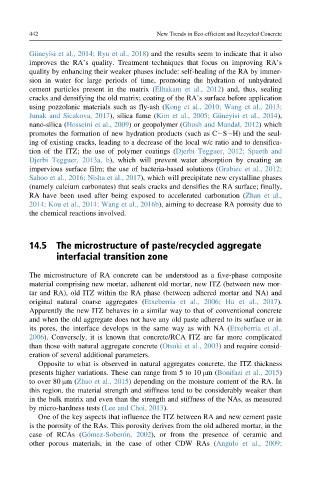Page 492 - New Trends in Eco efficient and Recycled Concrete
P. 492
442 New Trends in Eco-efficient and Recycled Concrete
Gu ¨neyisi et al., 2014; Ryu et al., 2018) and the results seem to indicate that it also
improves the RA’s quality. Treatment techniques that focus on improving RA’s
quality by enhancing their weaker phases include: self-healing of the RA by immer-
sion in water for large periods of time, promoting the hydration of unhydrated
cement particles present in the matrix (Elhakam et al., 2012) and, thus, sealing
cracks and densifying the old matrix; coating of the RA’s surface before application
using pozzolanic materials such as fly-ash (Kong et al., 2010; Wang et al., 2013;
Junak and Sicakova, 2017), silica fume (Kim et al., 2005; Gu ¨neyisi et al., 2014),
nano-silica (Hosseini et al., 2009) or geopolymer (Ghosh and Mandal, 2012) which
promotes the formation of new hydration products (such as C S H) and the seal-
ing of existing cracks, leading to a decrease of the local w/c ratio and to densifica-
tion of the ITZ; the use of polymer coatings (Djerbi Tegguer, 2012; Spaeth and
Djerbi Tegguer, 2013a, b), which will prevent water absorption by creating an
impervious surface film; the use of bacteria-based solutions (Grabiec et al., 2012;
Sahoo et al., 2016; Nisha et al., 2017), which will precipitate new crystalline phases
(namely calcium carbonates) that seals cracks and densifies the RA surface; finally,
RA have been used after being exposed to accelerated carbonation (Zhan et al.,
2014; Kou et al., 2014; Wang et al., 2016b), aiming to decrease RA porosity due to
the chemical reactions involved.
14.5 The microstructure of paste/recycled aggregate
interfacial transition zone
The microstructure of RA concrete can be understood as a five-phase composite
material comprising new mortar, adherent old mortar, new ITZ (between new mor-
tar and RA), old ITZ within the RA phase (between adhered mortar and NA) and
original natural coarse aggregates (Etxeberria et al., 2006; Hu et al., 2017).
Apparently the new ITZ behaves in a similar way to that of conventional concrete
and when the old aggregate does not have any old paste adhered to its surface or in
its pores, the interface develops in the same way as with NA (Etxeberria et al.,
2006). Conversely, it is known that concrete/RCA ITZ are far more complicated
than those with natural aggregate concrete (Otsuki et al., 2003) and require consid-
eration of several additional parameters.
Opposite to what is observed in natural aggregates concrete, the ITZ thickness
presents higher variations. These can range from 5 to 10 μm(Bonifazi et al., 2015)
to over 80 μm(Zhao et al., 2015) depending on the moisture content of the RA. In
this region, the material strength and stiffness tend to be considerably weaker than
in the bulk matrix and even than the strength and stiffness of the NAs, as measured
by micro-hardness tests (Lee and Choi, 2013).
One of the key aspects that influence the ITZ between RA and new cement paste
is the porosity of the RAs. This porosity derives from the old adhered mortar, in the
case of RCAs (Go ´mez-Sobero ´n, 2002), or from the presence of ceramic and
other porous materials, in the case of other CDW RAs (Angulo et al., 2009;

